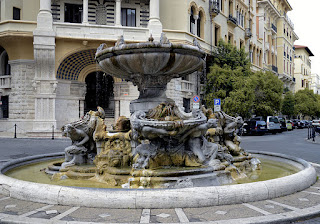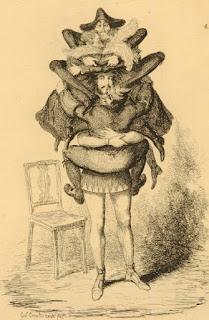Venetian best known for his discoveries at the Forum in Rome
 |
| Giacomo Boni was born in Venice but lived in Rome for much of his adult life |
His work within the ancient Roman site led to significant discoveries, including the Iron Age necropolis, the Lapis Niger, the Regia and other monuments.
Boni had a particular interest in stratigraphy, the branch of geology concerning subterranean layers of rock and other materials, and was among the first to apply the principles of stratigraphic excavation in the field of archaeological research.
The methods he employed in his work at the Forum still serve as a reference point today.
Boni was also an architect. In that area of his work, his masterpiece is considered to be the restoration of the Villa Blanc, a prestigious house that represents a unique example of eclectic art, a harmonious blend of elements and styles of different ages and cultures.
He served as a soldier during World War I, after which he embraced fascism, which he saw as an opportunity for the revival of ancient Roman religion and paganism, in which he had a keen interest. He joined the National Fascist Party, having become enthusiastic about Mussolini’s vision of a Fascist Italy as a kind of continuation of the Roman Empire. Mussolini in turn appointed him a senator in 1923.
Boni grew up in a strongly patriotic household, his father, a naval captain, having refused to swear allegiance to the Austrian Emperor at considerable cost to his status.
 |
| Boni photographed near the Arch of Trajan in 1907 |
In 1888 he was appointed secretary of the Royal Chalcography and, in 1890, inspector of monuments of the General Directorate of Antiquities and Fine Arts. He assisted in the Pantheon excavation in 1892 with Luca Beltrami and the architect, Giuseppe Sacconi, who would later be known as the designer of the Victor Emmanuel monument.
In 1895 he became director of the Regional Office of Monuments of Rome and, three years later, was appointed to direct the excavations of the Foro Romano, the Roman Forum.
Documents show that Boni’s research in the Forum was responsible for the discovery of the Lapis niger, the Regia, the Lacus Curtius, the Caesarian tunnels in the subsoil of the square, the archaic necropolis near the temple of Antoninus and Faustina and the church of Santa Maria Antiqua.
He demolished the church of Santa Maria Liberatrice in order to expose the ruins of Santa Maria Antiqua. His other discoveries included portions of the Column of Trajan.
Boni also worked on the slope of the Palatine Hill where he discovered the Mundus (tholos-cistern), a complex of tunnels leading to the Casa dei Grifi, the Aula Isiac and the Baths of Tiberius.
During his work on the renovation of Villa Blanc, a noble property set in parkland on the edge of the Trieste quarter to the northeast of Rome’s city centre, he also carried out some excavations that revealed the existence of a Roman mausoleum.
Boni’s embrace of Mussolini’s regime was short-lived, in the event. Two years after being made a senator, he became ill and died at the age of 66. His body was buried within the Orti Farnesiani sul Palatino, the botanical gardens on the Palatine Hill, overlooking the Forum.
 |
| The ruins of ancient Rome's Foro Romano are visited by 4.5 million people every year |
Rome's historic Forum, situated between Piazza Venezia and the Colosseum, was at the heart both of the ancient city of Rome and the Roman Empire itself, the nucleus of political affairs and commercial business, a place where elections took place and great speeches were made. The site fell into disrepair with the fall of the Empire and over time buildings were dismantled for the stone and marble, with much debris left behind. Eventually it was abandoned and became overgrown and was used mainly for grazing cattle. Attempts at uncovering and restoring buildings began in the early 19th century and the process of excavating areas long buried continues today. The impressive and extensive ruins are now one of Rome's major tourist attractions, drawing some 4.5 million visitors each year.
 |
| The Fontana delle Rane in Piazza Mincio in the Quartiere Coppedè in Rome's Trieste neighbourhood |
The Trieste quarter is the 17th quarter of Rome, located in the north-central area of the city. It borders the Aniene river to the north and northeast and is a neighbour of other notable quarters, such as Monte Sacro, Nomentano, Salario, and Parioli. It is an area with a rich history, one of its attractions being the ancient catacomb of Priscilla, a former quarry used for Christian burials from the late second century until the fourth century. The Trieste quarter houses the Quartiere Coppedè, an architectural complex known for its eclectic style, and Villa Albani, which holds a collection of classical art. The eastern part of Trieste is referred to as the African Quarter, its streets named after the colonies of the Kingdom of Italy. The quarter was once famous for the Piper Club, a 1960s bar and music venue that hosted the debut of the Italian pop star Patty Pravo and performances by Pink Floyd, Nirvana and the Beatles among others. Combining historical charm with a vibrant community feel, Trieste can offer a pleasant escape from the more tourist-dominated areas of Rome.
Also on this day:
1472: The death of Renaissance polymath Leon Battista Alberti
1815: The birth of inventor Giovanni Caselli
1973: The death of former World War I flying ace Ferruccio Ranza









